人教版(2019)选择性必修第二册Unit 5 First Aid Discover Useful Structures 课件(共25张PPT)
文档属性
| 名称 | 人教版(2019)选择性必修第二册Unit 5 First Aid Discover Useful Structures 课件(共25张PPT) | 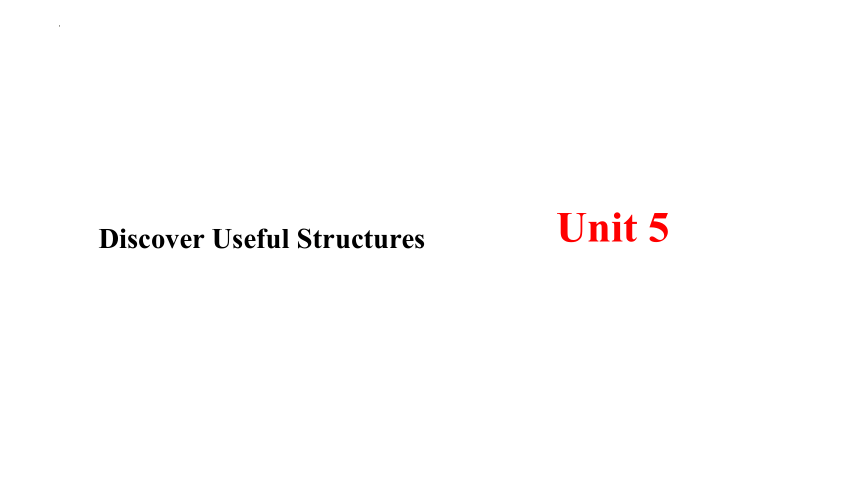 | |
| 格式 | pptx | ||
| 文件大小 | 451.7KB | ||
| 资源类型 | 教案 | ||
| 版本资源 | 人教版(2019) | ||
| 科目 | 英语 | ||
| 更新时间 | 2024-01-09 19:55:24 | ||
图片预览

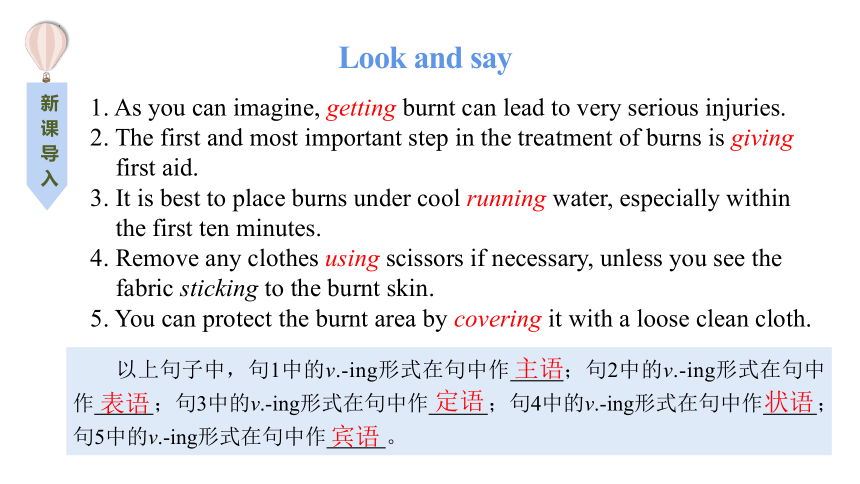


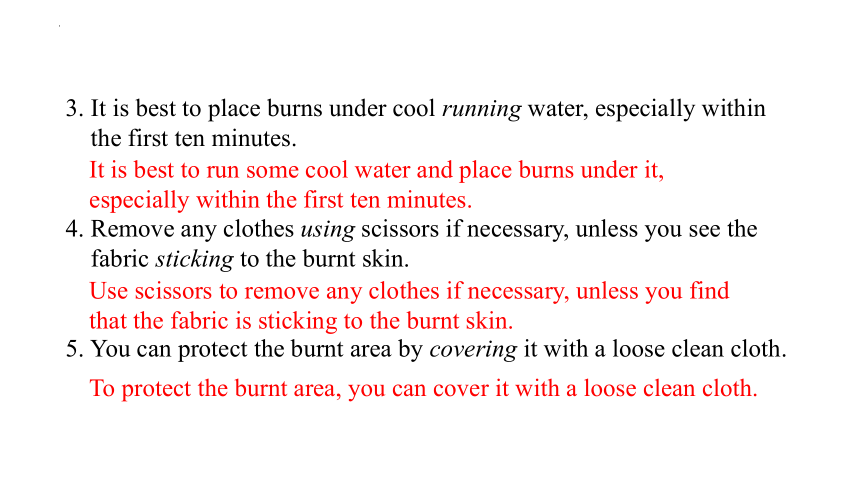
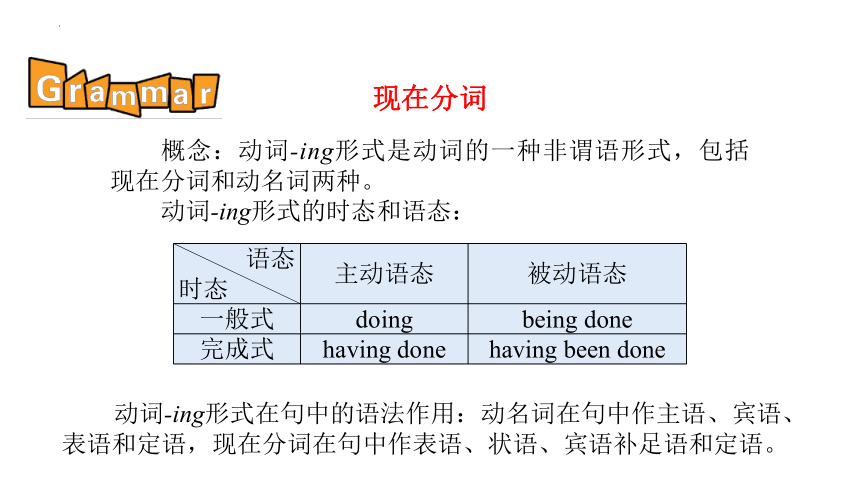


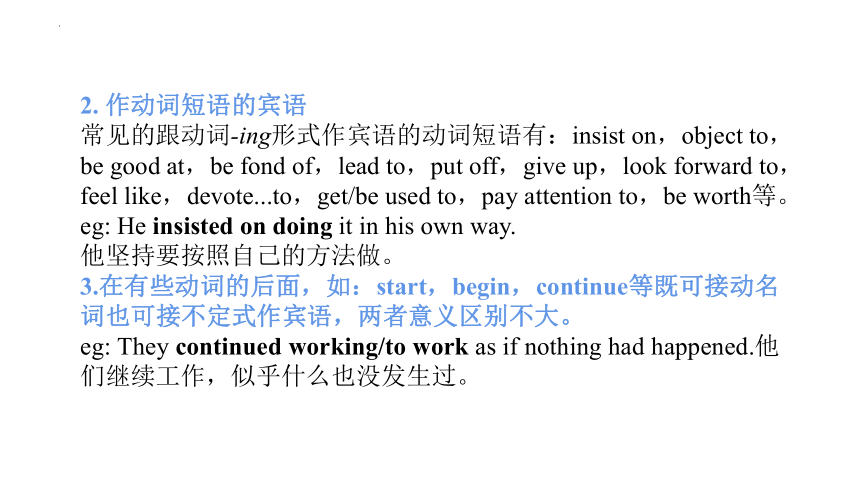
文档简介
(共25张PPT)
Unit 5
Discover Useful Structures
新 课 导 入
以上句子中,句1中的v.-ing形式在句中作 ;句2中的v.-ing形式在句中作 ;句3中的v.-ing形式在句中作 ;句4中的v.-ing形式在句中作 ;句5中的v.-ing形式在句中作 。
宾语
主语
表语
定语
状语
Look and say
1. As you can imagine, getting burnt can lead to very serious injuries.
2. The first and most important step in the treatment of burns is giving
first aid.
3. It is best to place burns under cool running water, especially within
the first ten minutes.
4. Remove any clothes using scissors if necessary, unless you see the
fabric sticking to the burnt skin.
5. You can protect the burnt area by covering it with a loose clean cloth.
1. 能复习和归纳动词-ing形式在句子中的功能和用法;
2. 能在语境中正确使用动词-ing的各种结构表达意义。
课 堂 学 习
Can you express the same ideas without using the -ing form
1. As you can imagine, getting burnt can lead to very serious injuries.
2. The first and most important step in the treatment of burns is giving
first aid.
As you can imagine, if you get burnt, it can lead to very serious injuries.
The first and most important step in the treatment of burns is to give first aid.
3. It is best to place burns under cool running water, especially within
the first ten minutes.
4. Remove any clothes using scissors if necessary, unless you see the
fabric sticking to the burnt skin.
5. You can protect the burnt area by covering it with a loose clean cloth.
It is best to run some cool water and place burns under it, especially within the first ten minutes.
Use scissors to remove any clothes if necessary, unless you find that the fabric is sticking to the burnt skin.
To protect the burnt area, you can cover it with a loose clean cloth.
现在分词
概念:动词-ing形式是动词的一种非谓语形式,包括现在分词和动名词两种。
动词-ing形式的时态和语态:
语态 时态 主动语态 被动语态
一般式 doing being done
完成式 having done having been done
动词-ing形式在句中的语法作用:动名词在句中作主语、宾语、表语和定语,现在分词在句中作表语、状语、宾语补足语和定语。
一、动词-ing形式作主语
动词-ing形式作主语时,往往表示经常性、习惯性的动作,通常置于句首。
Reading aloud is a good way to learn a language.
大声朗读是学习语言的一种好方法。
注意:
① 不定式作主语表示具体的或一次性的动作。
eg: To lie to her is wrong.对她撒谎不对。
② 动名词作主语时,谓语动词用单数。
eg: Climbing mountains is really difficult for the old.
对于老人来说爬山确实困难。
二、动词-ing形式作宾语
1. 作动词的宾语
常接动词-ing形式作宾语的动词可用下面的口诀帮助记忆:
避免错过少延期(avoid,miss,postpone)
建议完成多练习(advise/suggest,finish,practise)
喜欢想象禁不住(enjoy,imagine,can’t help)
承认否定与嫉妒(admit,deny,envy)
逃避冒险莫原谅(escape,risk,excuse)
忍受保持不介意(stand,keep,mind)
eg: Would you mind opening the window
你介意打开窗子吗?
2. 作动词短语的宾语
常见的跟动词-ing形式作宾语的动词短语有:insist on,object to,be good at,be fond of,lead to,put off,give up,look forward to,feel like,devote...to,get/be used to,pay attention to,be worth等。
eg: He insisted on doing it in his own way.
他坚持要按照自己的方法做。
3.在有些动词的后面,如:start,begin,continue等既可接动名词也可接不定式作宾语,两者意义区别不大。
eg: They continued working/to work as if nothing had happened.他们继续工作,似乎什么也没发生过。
动词 宾语的形式 意义
forget to do 忘记做……
doing 忘记做过……
remember to do 记着要去做……
doing 记得做过……
4.有些动词(短语)后跟不定式和动词-ing形式作宾语均可,但含义不同。常见的有:
regret to do 遗憾/抱歉要做……
doing 后悔做了……
try to do 尽力做……
doing 尝试做……
mean to do 打算做……
doing 意味着……
go on to do 接着做(另外一件事)
doing 接着做(同一件事)
stop to do 停下来去做……
doing 停止做……
5.下列动词可接动词-ing形式的主动形式表示被动意义,相当于不定式的被动形式。
need/want/require/deserve doing=need/want/require/deserve to be done
eg: The bike needs repairing/to be repaired.
这辆自行车需要修理。
三、动词-ing形式作表语
作表语的动词-ing形式包括现在分词和动名词。
1. 现在分词作表语,往往具有形容词的性质,说明主语的性质、特征等。作表语的现在分词,许多是由能够表示人们某种感情或情绪的动词变化而来的。常见的有:moving,interesting,encouraging,exciting,inspiring,boring,surprising,puzzling,amusing,astonishing...这类分词有“令人……的”的含义,常修饰物。
eg: The argument is very convincing.
这个论点很令人信服。
Your speech is very interesting and encouraging.
你的演讲很有趣而且很鼓舞人。
注意:不定式和动词-ed形式也可作表语,但不定式通常强调一次性的、具体的、将要发生的动作,动词-ed形式则表示被动、完成含义。
2. 动名词作表语多表示抽象性的或习惯性的动作,一般说明主语的内容。
eg: Her job is keeping the lecture hall as clean as possible.
=Keeping the lecture hall as clean as possible is her job.
她的工作是尽量使报告厅保持干净。
四、动词-ing形式作定语
及物动词 -ing形式作定语 被修饰的名词与非谓语动词为逻辑上的主动关系,动词-ing形式表示被修饰词的特征 I have never seen a more moving movie.
不及物动词-ing形式作定语 表示动作正在进行 The woman sending her children to school is my history teacher.
五、动词-ing形式作宾语补足语
常跟宾语补足语的谓语动词有 see, watch, hear, set, keep, find, have, get 等词。
eg: I saw him walking in the street.
我看见他在街上走。
I heard them singing in the classroom.
我听见他们在教室里唱歌。
We found the boy sleeping.
我们发现小孩睡着了。
六、动词-ing形式作状语
动词-ing形式作状语时,可以表示时间、原因、结果、条件、让步、方式、伴随情况等,其前可加连词while, when, once, if, unless等。
eg Crossing the street, he was knocked down by a car.
He fell off the bike, breaking his left leg.
A group of children were sitting around the teacher, playing games.
Replace each underlined part with a suitable -ing form and rewrite the sentence as necessary.
2
1 When he got out of the bathtub, he slipped and fell on the floor.
2 Is there any reason why we are not going to have the first-aid training
this week
When getting out of the bathtub, he slipped and fell on the floor.
Is there any reason for not having the first-aid training this week
3 She had been told about the risk of electric shocks and this made her
very careful while using hairdryers.
4 Because the child was not watched carefully by his parents, he
touched a hot iron and burnt his finger.
5 After she had been bitten by mosquitoes, she applied some medicine
to her skin.
Having been told about the risk of electric shocks, she was very careful while using hairdryers.
Not being watched carefully by his parents, the child touched a hot iron and burnt his finger.
After being/having been bitten by mosquitoes, she applied some medicine to her skin.
Work with a partner and summarise the different structures of the -ing form. When is each one used
basic form: doing
negative form: not doing
negative passive form: not being done
perfect passive form: having been done
Complete the passage with the correct forms of the given words. What happened to Mrs Taylor
3
Mrs Taylor was an elderly woman ______(live) alone. One day, she was in her living room cleaning the windows, when suddenly she could no longer feel the right side of her body. ______(try) to walk to her sofa to sit down, she fell over onto the carpet. Then she realised that she could not get up, and that she was having trouble ________(breathe). Fortunately, she had her mobile phone with her, and she was able to reach it with her left hand while ______(lie) on the floor. Her mobile phone _______________(already, set up) to call an emergency number at the push of a button, so it was easy to call for help.
living
Trying
breathing
lying
was already set up
While attempting to talk to the operator, Mrs Taylor discovered that she could not speak. __________(not, hear) an answer, the operator knew that Mrs Taylor must be in trouble. Telling Mrs Taylor that everything would be OK, she immediately sent an ambulance. After ________(arrive), the ambulance team quickly found Mrs Taylor and without delay gave her oxygen, put in an IV needle, and checked her vital signs. _______________(take) to the hospital and treated immediately, Mrs Taylor's health was in no great danger, though she had to stay in the hospital ward. After a week, her __________ (frighten) experience was over, and she was allowed to go home.
Not hearing
arriving
Having been taken
frightening
delay vi.&vt.推迟;延期(做某事) vt. 耽误;耽搁 n. 延误;耽搁(的时间);推迟
Eg: After arriving, the ambulance team quickly found Mrs Taylor and without delay gave her oxygen, put in an IV needle, and checked her vital signs. 救援队到达之后,很快就发现了泰勒女士,然后立刻给她输氧,进行静脉注射并检查她的生命体征。
Key points
[归纳拓展]
without delay 马上
a delay of two hours/a two-hour delay 两小时的延误
delay doing sth 推迟做某事
[即学即练] 单句语法填空
1. Women who put _____ having a baby often make the best mothers.
2. They had delayed ________(have) children, for the usual reason,
to establish their careers.
off
having
Work in pairs and discuss the following questions.
4
1. What should people do when facing a frightening experience like Mrs
Taylor's
2. What are some risks that elderly people may encounter when living alone
3. What can we do to help prevent elderly people from taking unnecessary
risks
When having a frightening experience like Mrs Taylor's, people should try to get help, like she did.
When living alone, elderly people may fall or get injured, and not be able to help themselves or even call for help.
To help prevent elderly people from taking unnecessary risks, we should make sure that their homes are easy to get around in, with handrails, ramps instead of stairs, and even walking surfaces.
Now let's summarise the use of the V.-ing together!
Unit 5
Discover Useful Structures
新 课 导 入
以上句子中,句1中的v.-ing形式在句中作 ;句2中的v.-ing形式在句中作 ;句3中的v.-ing形式在句中作 ;句4中的v.-ing形式在句中作 ;句5中的v.-ing形式在句中作 。
宾语
主语
表语
定语
状语
Look and say
1. As you can imagine, getting burnt can lead to very serious injuries.
2. The first and most important step in the treatment of burns is giving
first aid.
3. It is best to place burns under cool running water, especially within
the first ten minutes.
4. Remove any clothes using scissors if necessary, unless you see the
fabric sticking to the burnt skin.
5. You can protect the burnt area by covering it with a loose clean cloth.
1. 能复习和归纳动词-ing形式在句子中的功能和用法;
2. 能在语境中正确使用动词-ing的各种结构表达意义。
课 堂 学 习
Can you express the same ideas without using the -ing form
1. As you can imagine, getting burnt can lead to very serious injuries.
2. The first and most important step in the treatment of burns is giving
first aid.
As you can imagine, if you get burnt, it can lead to very serious injuries.
The first and most important step in the treatment of burns is to give first aid.
3. It is best to place burns under cool running water, especially within
the first ten minutes.
4. Remove any clothes using scissors if necessary, unless you see the
fabric sticking to the burnt skin.
5. You can protect the burnt area by covering it with a loose clean cloth.
It is best to run some cool water and place burns under it, especially within the first ten minutes.
Use scissors to remove any clothes if necessary, unless you find that the fabric is sticking to the burnt skin.
To protect the burnt area, you can cover it with a loose clean cloth.
现在分词
概念:动词-ing形式是动词的一种非谓语形式,包括现在分词和动名词两种。
动词-ing形式的时态和语态:
语态 时态 主动语态 被动语态
一般式 doing being done
完成式 having done having been done
动词-ing形式在句中的语法作用:动名词在句中作主语、宾语、表语和定语,现在分词在句中作表语、状语、宾语补足语和定语。
一、动词-ing形式作主语
动词-ing形式作主语时,往往表示经常性、习惯性的动作,通常置于句首。
Reading aloud is a good way to learn a language.
大声朗读是学习语言的一种好方法。
注意:
① 不定式作主语表示具体的或一次性的动作。
eg: To lie to her is wrong.对她撒谎不对。
② 动名词作主语时,谓语动词用单数。
eg: Climbing mountains is really difficult for the old.
对于老人来说爬山确实困难。
二、动词-ing形式作宾语
1. 作动词的宾语
常接动词-ing形式作宾语的动词可用下面的口诀帮助记忆:
避免错过少延期(avoid,miss,postpone)
建议完成多练习(advise/suggest,finish,practise)
喜欢想象禁不住(enjoy,imagine,can’t help)
承认否定与嫉妒(admit,deny,envy)
逃避冒险莫原谅(escape,risk,excuse)
忍受保持不介意(stand,keep,mind)
eg: Would you mind opening the window
你介意打开窗子吗?
2. 作动词短语的宾语
常见的跟动词-ing形式作宾语的动词短语有:insist on,object to,be good at,be fond of,lead to,put off,give up,look forward to,feel like,devote...to,get/be used to,pay attention to,be worth等。
eg: He insisted on doing it in his own way.
他坚持要按照自己的方法做。
3.在有些动词的后面,如:start,begin,continue等既可接动名词也可接不定式作宾语,两者意义区别不大。
eg: They continued working/to work as if nothing had happened.他们继续工作,似乎什么也没发生过。
动词 宾语的形式 意义
forget to do 忘记做……
doing 忘记做过……
remember to do 记着要去做……
doing 记得做过……
4.有些动词(短语)后跟不定式和动词-ing形式作宾语均可,但含义不同。常见的有:
regret to do 遗憾/抱歉要做……
doing 后悔做了……
try to do 尽力做……
doing 尝试做……
mean to do 打算做……
doing 意味着……
go on to do 接着做(另外一件事)
doing 接着做(同一件事)
stop to do 停下来去做……
doing 停止做……
5.下列动词可接动词-ing形式的主动形式表示被动意义,相当于不定式的被动形式。
need/want/require/deserve doing=need/want/require/deserve to be done
eg: The bike needs repairing/to be repaired.
这辆自行车需要修理。
三、动词-ing形式作表语
作表语的动词-ing形式包括现在分词和动名词。
1. 现在分词作表语,往往具有形容词的性质,说明主语的性质、特征等。作表语的现在分词,许多是由能够表示人们某种感情或情绪的动词变化而来的。常见的有:moving,interesting,encouraging,exciting,inspiring,boring,surprising,puzzling,amusing,astonishing...这类分词有“令人……的”的含义,常修饰物。
eg: The argument is very convincing.
这个论点很令人信服。
Your speech is very interesting and encouraging.
你的演讲很有趣而且很鼓舞人。
注意:不定式和动词-ed形式也可作表语,但不定式通常强调一次性的、具体的、将要发生的动作,动词-ed形式则表示被动、完成含义。
2. 动名词作表语多表示抽象性的或习惯性的动作,一般说明主语的内容。
eg: Her job is keeping the lecture hall as clean as possible.
=Keeping the lecture hall as clean as possible is her job.
她的工作是尽量使报告厅保持干净。
四、动词-ing形式作定语
及物动词 -ing形式作定语 被修饰的名词与非谓语动词为逻辑上的主动关系,动词-ing形式表示被修饰词的特征 I have never seen a more moving movie.
不及物动词-ing形式作定语 表示动作正在进行 The woman sending her children to school is my history teacher.
五、动词-ing形式作宾语补足语
常跟宾语补足语的谓语动词有 see, watch, hear, set, keep, find, have, get 等词。
eg: I saw him walking in the street.
我看见他在街上走。
I heard them singing in the classroom.
我听见他们在教室里唱歌。
We found the boy sleeping.
我们发现小孩睡着了。
六、动词-ing形式作状语
动词-ing形式作状语时,可以表示时间、原因、结果、条件、让步、方式、伴随情况等,其前可加连词while, when, once, if, unless等。
eg Crossing the street, he was knocked down by a car.
He fell off the bike, breaking his left leg.
A group of children were sitting around the teacher, playing games.
Replace each underlined part with a suitable -ing form and rewrite the sentence as necessary.
2
1 When he got out of the bathtub, he slipped and fell on the floor.
2 Is there any reason why we are not going to have the first-aid training
this week
When getting out of the bathtub, he slipped and fell on the floor.
Is there any reason for not having the first-aid training this week
3 She had been told about the risk of electric shocks and this made her
very careful while using hairdryers.
4 Because the child was not watched carefully by his parents, he
touched a hot iron and burnt his finger.
5 After she had been bitten by mosquitoes, she applied some medicine
to her skin.
Having been told about the risk of electric shocks, she was very careful while using hairdryers.
Not being watched carefully by his parents, the child touched a hot iron and burnt his finger.
After being/having been bitten by mosquitoes, she applied some medicine to her skin.
Work with a partner and summarise the different structures of the -ing form. When is each one used
basic form: doing
negative form: not doing
negative passive form: not being done
perfect passive form: having been done
Complete the passage with the correct forms of the given words. What happened to Mrs Taylor
3
Mrs Taylor was an elderly woman ______(live) alone. One day, she was in her living room cleaning the windows, when suddenly she could no longer feel the right side of her body. ______(try) to walk to her sofa to sit down, she fell over onto the carpet. Then she realised that she could not get up, and that she was having trouble ________(breathe). Fortunately, she had her mobile phone with her, and she was able to reach it with her left hand while ______(lie) on the floor. Her mobile phone _______________(already, set up) to call an emergency number at the push of a button, so it was easy to call for help.
living
Trying
breathing
lying
was already set up
While attempting to talk to the operator, Mrs Taylor discovered that she could not speak. __________(not, hear) an answer, the operator knew that Mrs Taylor must be in trouble. Telling Mrs Taylor that everything would be OK, she immediately sent an ambulance. After ________(arrive), the ambulance team quickly found Mrs Taylor and without delay gave her oxygen, put in an IV needle, and checked her vital signs. _______________(take) to the hospital and treated immediately, Mrs Taylor's health was in no great danger, though she had to stay in the hospital ward. After a week, her __________ (frighten) experience was over, and she was allowed to go home.
Not hearing
arriving
Having been taken
frightening
delay vi.&vt.推迟;延期(做某事) vt. 耽误;耽搁 n. 延误;耽搁(的时间);推迟
Eg: After arriving, the ambulance team quickly found Mrs Taylor and without delay gave her oxygen, put in an IV needle, and checked her vital signs. 救援队到达之后,很快就发现了泰勒女士,然后立刻给她输氧,进行静脉注射并检查她的生命体征。
Key points
[归纳拓展]
without delay 马上
a delay of two hours/a two-hour delay 两小时的延误
delay doing sth 推迟做某事
[即学即练] 单句语法填空
1. Women who put _____ having a baby often make the best mothers.
2. They had delayed ________(have) children, for the usual reason,
to establish their careers.
off
having
Work in pairs and discuss the following questions.
4
1. What should people do when facing a frightening experience like Mrs
Taylor's
2. What are some risks that elderly people may encounter when living alone
3. What can we do to help prevent elderly people from taking unnecessary
risks
When having a frightening experience like Mrs Taylor's, people should try to get help, like she did.
When living alone, elderly people may fall or get injured, and not be able to help themselves or even call for help.
To help prevent elderly people from taking unnecessary risks, we should make sure that their homes are easy to get around in, with handrails, ramps instead of stairs, and even walking surfaces.
Now let's summarise the use of the V.-ing together!
